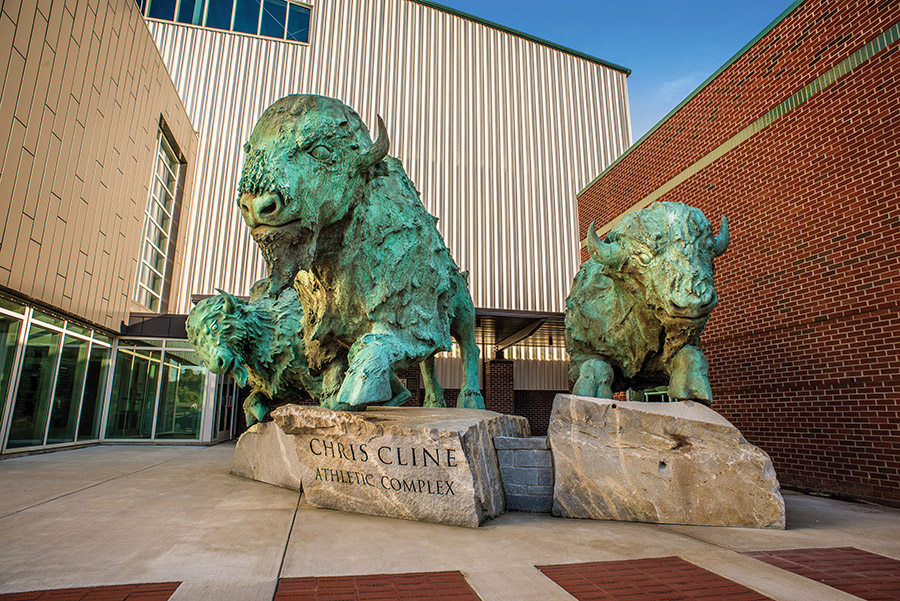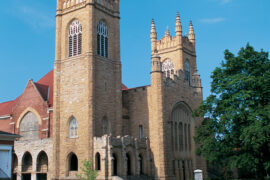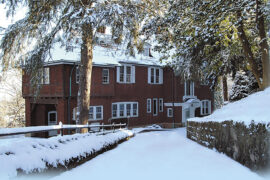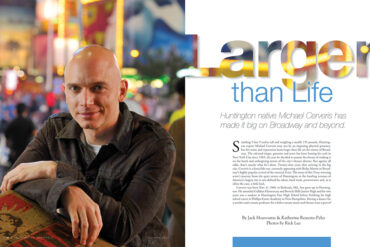Local statues represent aspects of Huntington’s history and culture.
By James E. Casto
HQ 98 | SUMMER 2017
Statues are created as a way of paying tribute to a person or, sometimes, an idea. In Huntington, a number of statues have been erected over the years. We walk or drive past one or more of them every day and seldom give a passing thought to when or why they were built and what they symbolize. Here are the stories behind five Huntington statues. First up, the story of a statue that honors a man who built a railroad — and a brand-new town.

Collis P. Huntington
935 Seventh Ave.
The statue of town founder Collis P. Huntington that stands in front of the city’s former Chesapeake & Ohio Railway passenger station on Seventh Avenue has been a familiar local landmark since it was erected in 1924. Yet, odds are that few who glimpse the statue can name the gifted artist who sculpted it.
Gutzon Borglum, the sculptor who crafted the Mount Rushmore Monument with its giant heads of Washington, Jefferson, Theodore Roosevelt and Lincoln, created the Huntington statue.
How did an artist who would go on to create Mount Rushmore first do a statue of rail tycoon Huntington? That’s an intriguing story — one that’s even tinged with a hint of scandal.
When the directors of the all-but-bankrupt Chesapeake & Ohio Railway desperately needed money to pay the railroad’s debts and extend its tracks from Richmond, Virginia, across the then-new state of West Virginia to the Ohio River, they turned to Huntington for help. He gladly supplied the money — and installed himself as C&O president.
Personally exploring the C&O’s proposed route, Huntington decided that a stretch of bottomland along the Ohio just downstream from the village of Guyandotte would be an ideal spot for the railroad’s western terminus. Soon a brand-new town was emerging there — a town named, appropriately enough, Huntington.
Elizabeth, the rail tycoon’s first wife, died in 1883, and the following year he married Arabella “Belle” Yarrington, who had a son, Archer. Huntington adopted the 14-year-old boy saying, “I couldn’t love him more if he were my own son.” Here’s where a whiff of scandal comes in. The gossips of the day insisted that Arabella had been Huntington’s mistress for years and that Archer was, in fact, his biological son.
Whatever the true relationship between Collis and Archer, Collis was clearly a surrogate father to his favorite nephew, Henry, the son of his brother Solon.
When Collis died in 1900, his will split the bulk of his fortune — estimated at $70 million — between his widow and favorite nephew. At the time some newspapers described her as “the richest woman in America.” It was Arabella and Henry who commissioned the Borglum statue.
Arabella died in 1924. Six weeks after her death, the statute of Collis was unveiled in his namesake city. Henry was scheduled to attend the ceremony on October 23, 1924, but only days before the event he telegraphed his regrets. A crowd estimated by The Huntington Advertiser at more than 7,000 people jammed the area around the C&O station to witness the ceremony.
Borglum’s Huntington statue quickly became a familiar part of the city scene and stood in front of the C&O station for more than 50 years. In 1977, when the city’s former Baltimore & Ohio Railroad depot was turned into the restaurant/retail complex known as Heritage Station, the Huntington statue was moved there. One wonders what the often blunt-spoken rail baron would have said about being memorialized at a rival railroad station.
In 1999, at the request of CSX Transportation, the statue was returned to the former C&O station and its place of honor there.

American Soldier
1200 Veterans Memorial Blvd.
When Huntington founded his new town, he hired a Boston civil engineer, Rufus Cook, to draw up a town plan and gave him some specific instructions.
Huntington said he wanted a perfect geometric grid work of streets and avenues, each consecutively numbered so any address would be easy to find.
But, look at a current map of downtown Huntington, and you’ll find a roadway that was never envisioned by Huntington. It’s Veterans Memorial Boulevard, a thoroughfare that honors the community’s veterans. Built as part of the city’s downtown urban renewal program, Veterans Memorial Boulevard runs east to west from 13th Street to Fifth Street. Anchoring its eastern end, at the downtown U.S. Post Office, is a statue of an American soldier.
Dedicated July 4, 1980, the statue was erected “In Memory of All Veterans” by the Veterans Committee for Civic Improvement, a coalition of a dozen Huntington area veterans organizations.

Carter G. Woodson
820 Hal Greer Blvd.
Carter G. Woodson, a graduate of Huntington’s old all-black Douglass High School who went on to earn a Ph.D. from Harvard University, is widely recognized as the “Father of Black History Month.”
Woodson was born in 1875 in Buckingham County, Virginia. As jobs opened up in West Virginia’s coal mines and railroads, many black families migrated across the mountains from Virginia. Young Woodson’s family was among them. At age 19, he enrolled at Douglass High. He finished the four-year course in two years, and then he went on to earn a degree from Berea College in Kentucky. In 1900, he returned to Huntington and became principal at Douglass.
He earned another bachelor’s degree and master’s degree from the University of Chicago and in 1912 became the second black man to earn a Ph.D. from Harvard. (William E. Dubois was the first).
In 1915, Woodson organized the Association for the Study of Negro Life, where he served as director, researcher, editor and janitor. The next year, he founded the influential Journal of Negro History. Today’s observance of Black History Month can be traced directly to his pioneering efforts. He spent his later years in Washington, D.C., where he died in 1950.
Woodson’s fame has spread over the years. In 1984, the U.S. Postal Service issued a stamp in his honor — a fitting tribute to him and his influential legacy. Yet, he long went virtually unremembered and unacknowledged in his adopted hometown of Huntington.
Today, fortunately, that has changed. A statue of the famed black educator stands at the Carter G. Woodson Apartments on Huntington’s Hal Greer Boulevard.
And the Woodson Memorial Foundation, which dedicated the statue September 29, 1995, is continuing its efforts to keep his memory alive.
The statue’s creator, James Lykins, of Elkview, West Virginia, said he didn’t know who Woodson was until he entered the competition to sculpt his likeness.
“At first, it was just a job,” he said. “Then, I got into the character. He’s an inspiration.”
In a sense, Woodson’s statue honors not just one man but the many black citizens of vision and accomplishment who helped build Huntington into the community it is today.

Chief Justice John Marshall
1 John Marshall Dr.
John Marshall grew up on the Virginia frontier. At the age of 20, he joined the Continental Army to fight for American independence. He later entered the practice of law in Richmond and by 1790 had become the leading appellate lawyer in Virginia. He served in the House of Delegates, the state executive council and as a delegate to the Virginia Convention that ratified the U.S. Constitution. He was elected to Congress in 1799, and appointed secretary of state in 1800.
In 1801, President John Adams named Marshall as chief justice of the United States. In that role, Marshall’s great decisions shaped the basis of American constitutional law and established the authority of the Supreme Court.
Marshall died in 1835, two years before the founding of Marshall Academy (now University), thus the famed jurist never knew that his friend and colleague John Laidley had been successful in having the new school named for him.
A highly visible symbol of the university’s respect for its namesake is an eight-foot bronze statue of John Marshall that stands outside the John Deaver Drinko Library facing John Marshall Drive. Created by noted American sculptor William Behrends of Tryon, North Carolina, the giant statue was unveiled in 1998.
The long-time desire to erect a statue of Marshall on campus became a reality with the construction of the Drinko Library. A plaza, or commons area, was envisioned adjacent to the library, and its construction offered a clear opportunity to erect a statue that would enhance the profile of the university’s namesake on campus.
The statue portrays the chief justice in his judicial robes, stepping forward. The book held in the left hand symbolizes his early education at home on the Virginia frontier. The six-foot base is engraved with the words “Revolutionary soldier. Definer of the Constitution. Devoted husband and father.”

Thundering Herd
2263 Third Ave.
Since 2015, three massive bronzed buffalo statues have stood guard at Marshall University’s Chris Cline Athletic Complex. The statues are the creation of world-renowned artist Stan Mullins of Athens, Georgia. Each of the three statues weighs nearly 6,000 pounds while the pedestals they stand on are even bigger and heavier. They range from 34,00 to 41,000 pounds apiece.
Though each statue looks like it’s one single piece, each is actually made up of 60 to 80 individual pieces. Once the pieces were carefully assembled, they were welded together and then the weld marks were ground down.
The three statues cost a total of $1 million, an outlay covered by Chris Cline’s substantial donation for the athletic complex that bears his name.
Mullins has said he hopes the massive statues inspire Marshall to “really thunder into the future.” When asked why he created three statues and not just one, he explained: “Well, one is a buffalo, two is a couple and three is a herd.”




